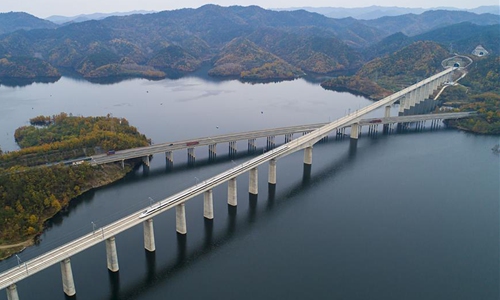
Aerial photo taken on Nov. 26, 2019 shows a train running on a bridge over the Danjiangkou reservoir during a trial of Wuhan-Shiyan high-speed railway in central China's Hubei Province. (Photo: Xinhua)
China's newly built urban rail lines have reached a record high in 2019, making China the No.1 country in urban rail lines construction scale for over a decade, an industry analyst said Wednesday.
A total of 40 cities in the Chinese mainland had opened 6,730.27 kilometers of urban rail transit lines in 2019. Among them, 968.77 kilometers of new urban rail lines had been built throughout the year, setting a record high, according to the China Urban Rail Transit Association on Wednesday.
Chen Yanshen, a research fellow with the China Academy of Urban Planning and Design told the Global Times on Wednesday that China has maintained being the world's No. 1 urban rail country in terms of construction scale and speed over the past decade.
"The development of China's national urban rail lines is among the highest in the world. We are not only the most advanced in investment intensity and investment scale, but also in the number of completed projects, and technology," Chen said.
China's leading position is driven by the rising demand for public transport and the development in first- and second-tier cities and between cities.
"There are more than 50 million passengers per day using urban rail lines across the country, and for cities like Beijing, Shanghai and Guangzhou [South China's Guangdong Province], which are the largest cities in the world in terms of urban rail line systems, they carry over 10 million passengers per day, compared with 8 million in New York per day," Chen said.
"Smaller cities like Changzhou [East China's Jiangsu Province] and Hohhot [capital of North China's Inner Mongolia Autonomous Region, which used to be relatively poor places, now have economic development and policy in place, and have the capability to build urban rail systems," Chen said.
Meanwhile, urban rail line systems are also changing from serving one city to city clusters.
In March 2019, the National Development and Reform Commission proposed to strengthen the support of the transportation network, including the construction of a multi-level rapid transportation network based on rail transit and expressways in city clusters and metropolitan areas.
With the national policy in place, the urban rail of the Yangtze River Delta and Pearl River Delta will be integrated to serve a bigger economic circle, according to Chen.


